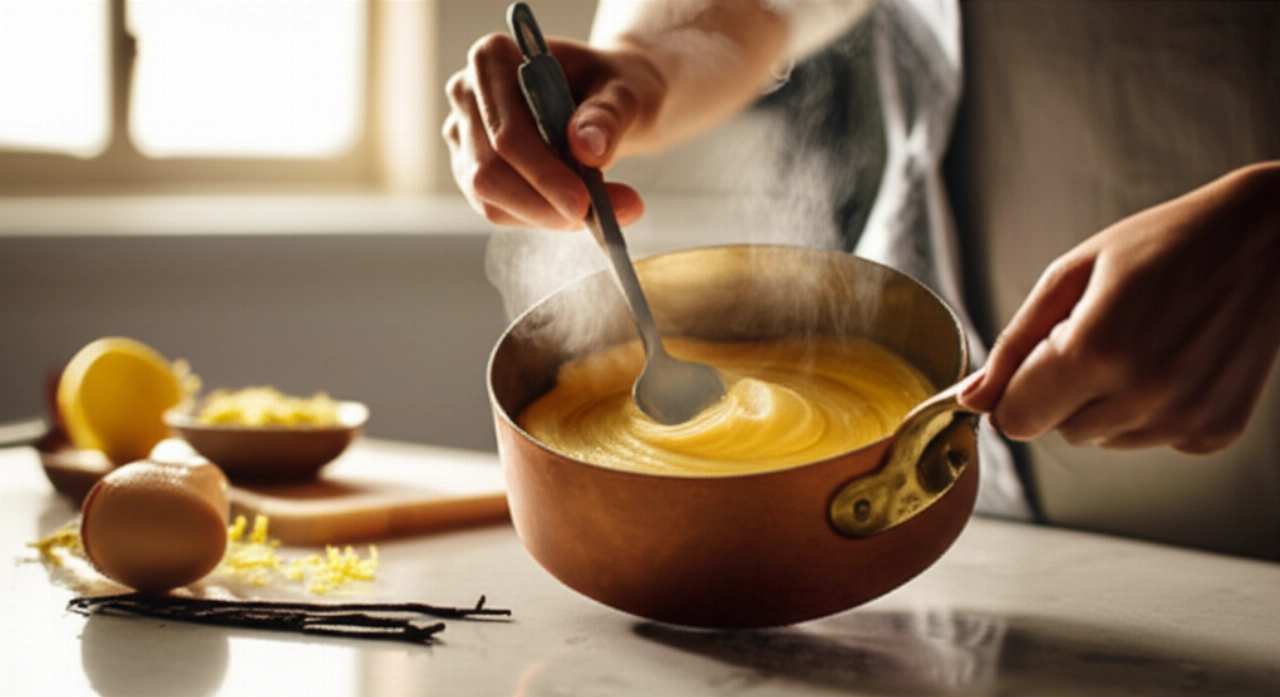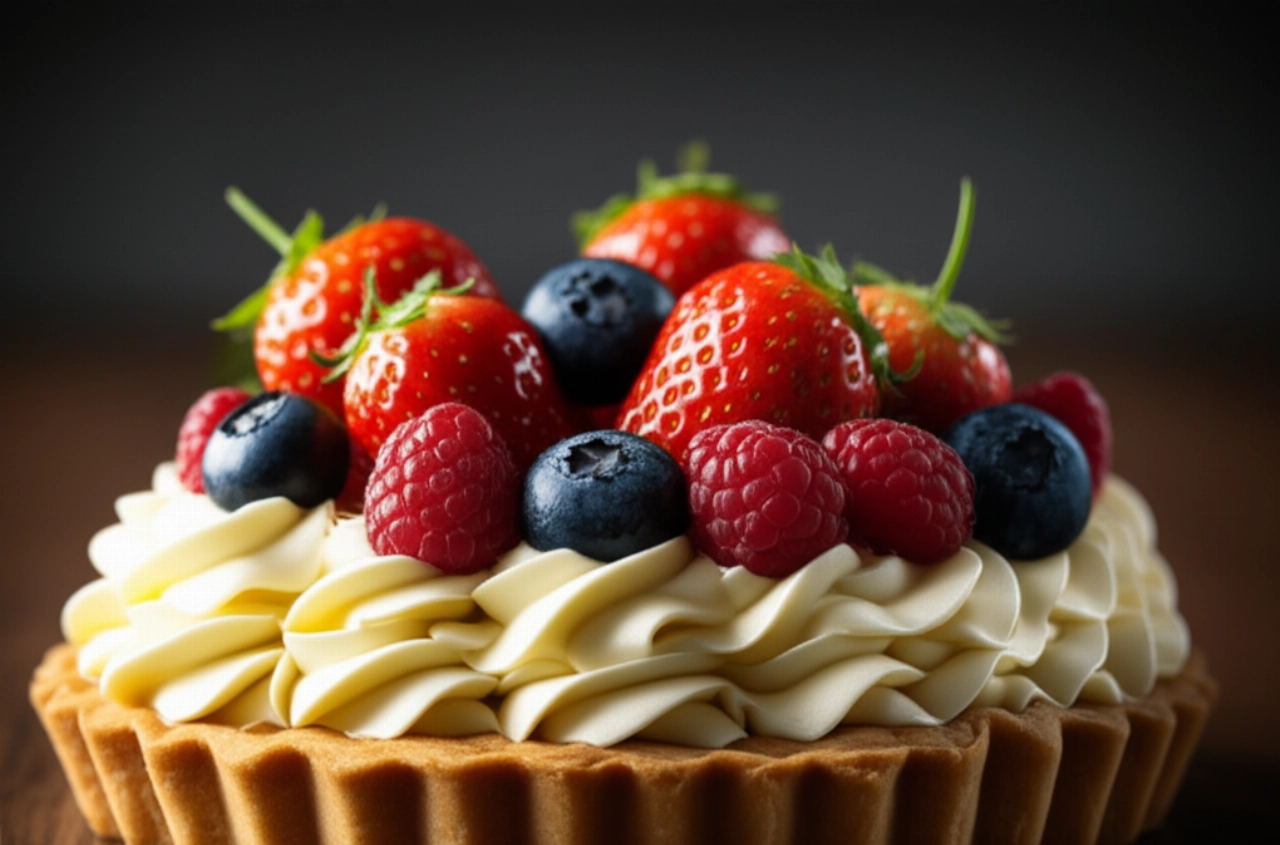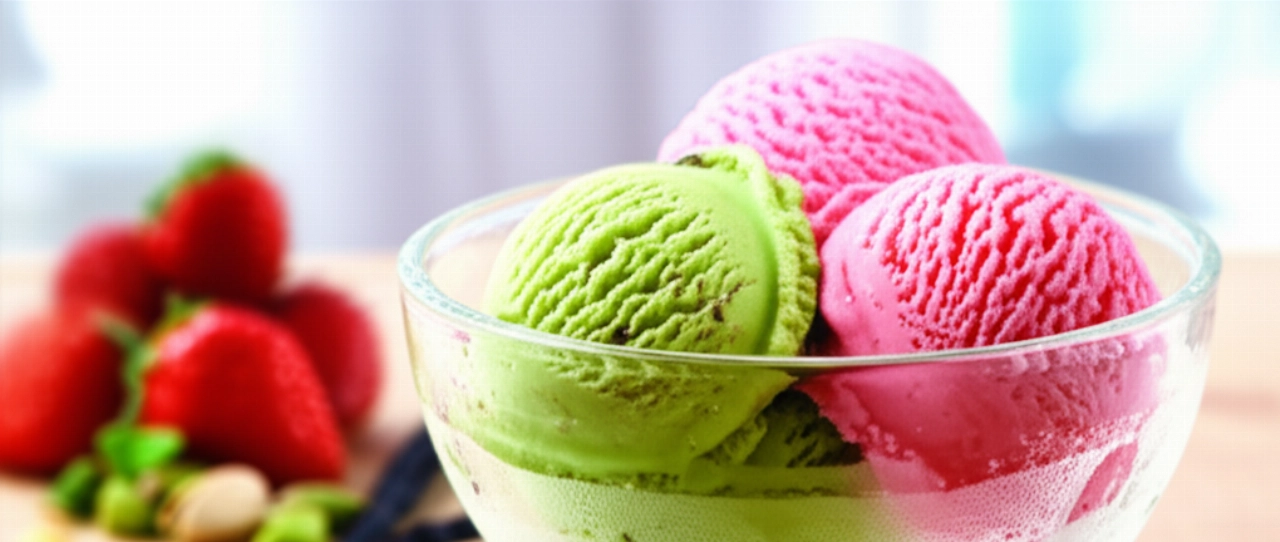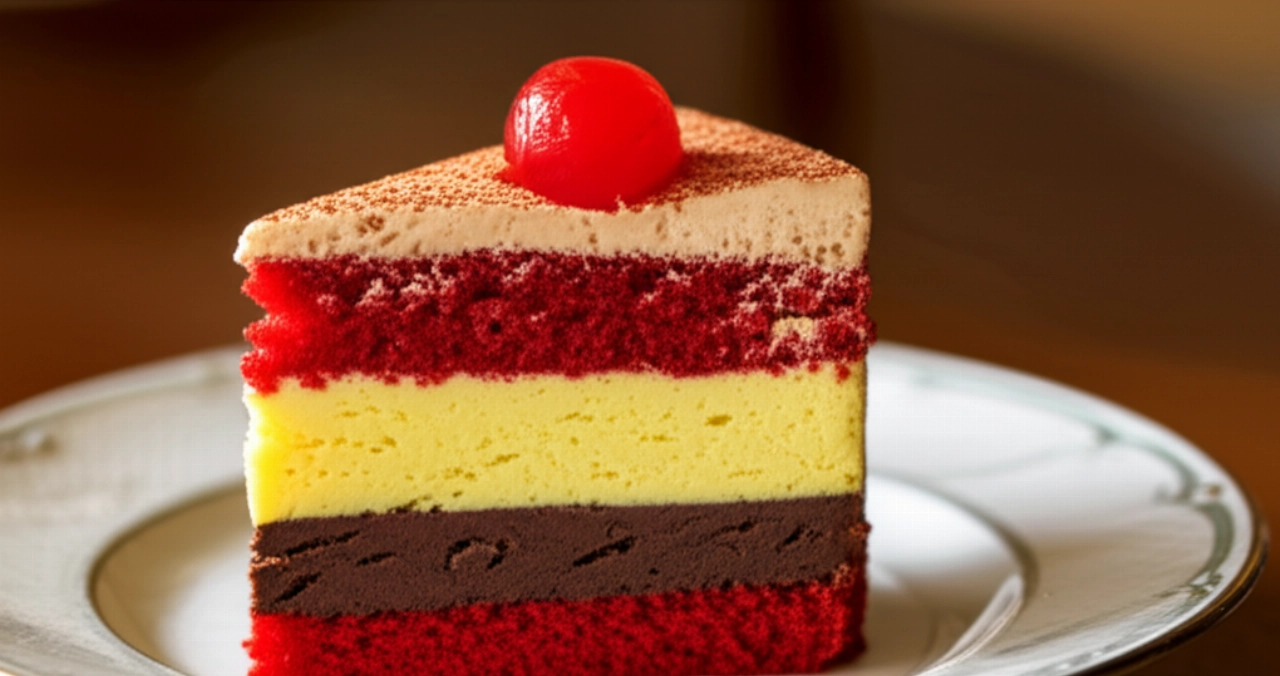Dreaming of a pastry cream so velvety it melts in your mouth, shiny, incredibly fragrant, and without the slightest lump? The kind that makes you close your eyes at the first taste and takes you back to the authentic flavors of old-fashioned pastry? The one that turns every dessert into a masterpiece, from a simple tart to the most elaborate cream puffs?
But how many times have you ended up with stubborn lumps, a consistency that's too runny, or, worse, an overly "eggy" taste that ruins everything? Finding the right recipe, one that guarantees success without anxiety, seems almost impossible, and the fear of wasting precious ingredients holds you back from trying.
Make yourself comfortable, because your search ends here. On Search Recipes, your kitchen transforms into a laboratory of guaranteed successes. Here you won't just find a list of ingredients, but the definitive guide, full of inherited and perfected tricks and tips, to prepare the best and most perfect Pastry Cream you've ever tasted. Success is guaranteed, and every spoonful will be a round of applause!

The Strategic Pillar: Our Promise of Velvety Perfection
Our mission is simple yet powerful: to forever eliminate lumps and eggy flavor from your pastry cream, guaranteeing an incredibly velvety, shiny consistency and an enveloping aroma that will win everyone over. I will guide you step by step, revealing every secret to achieve an impeccable cream, just like those from the best patisseries, but made with your own hands, in your kitchen. Forget past disappointments, here you will feel at home and the result will be a triumph of taste and texture.

Ingredients for a Dream Pastry Cream: The Choice That Makes the Difference
For a truly exceptional pastry cream, the quality and choice of ingredients are fundamental. It's not just a list, but a reasoned selection, the "why" behind each element.
- Fresh Whole Milk (500 ml): Do not use skimmed milk! Whole milk is the base of creaminess and rich flavor. Its fat content is essential for a velvety texture and full taste. If possible, choose high-quality fresh milk.
- Very Fresh Egg Yolks (4-5 large): They are the heart of our cream. Yolks provide color, flavor, and, most importantly, the perfect density and emulsion. We only use yolks to prevent the egg white, with its proteins, from "tearing" the cream or giving it a less smooth, almost omelet-like consistency. Freshness is crucial for flavor and safety.
- Granulated Sugar (150 g): Not only does it sweeten, but it also helps stabilize the yolks and prevent premature coagulation. The quantity is balanced for perfect sweetness, without being cloying.
- Corn Starch (Maizena) or 00 Flour (40 g): Here lies one of the secrets of consistency. Corn starch (Maizena) is our favorite because it guarantees a shinier, more transparent, and velvety cream, without a floury aftertaste. If you use 00 flour, the cream will be slightly more opaque and dense, but still excellent. You can also use a mix to balance the consistencies.
- Organic Lemon Zest or Vanilla Bean: These are the aromas that make the cream unforgettable. Lemon zest (only the yellow part, please!) gives an unmistakable citrus freshness. If you prefer, a vanilla bean (sliced lengthwise to extract the seeds) provides a warm and enveloping fragrance. Avoid artificial flavors, they would ruin the magic!

The 3 Common Mistakes in Pastry Cream (and How to Avoid Them Forever)
Don't worry, it's normal to encounter some obstacles. But with these tips, you'll turn every pitfall into a success!
- Lumps, the Number One Enemy: The main cause is adding flour/starch directly to hot liquids without first thoroughly mixing it with the yolks and sugar.
- How to avoid them: Make sure to create a "paste" smooth and lump-free with yolks, sugar, and starch/flour before adding the hot milk. And, crucially, always strain the hot milk (after flavoring it) before combining it with the egg mixture. This will remove any lemon or vanilla residues and give you a pure base.
- Eggy Flavor (or "omelet-like"): This happens due to not-so-fresh eggs or insufficient/excessive cooking.
- How to avoid it: Always use very fresh eggs. Cook the cream over medium-low heat, stirring constantly, until it thickens and the first bubbles appear. Once it boils (and not before!), let it simmer for 1-2 minutes, stirring vigorously. This allows the starch to cook completely and the eggy flavor to diminish.
- Wrong Consistency (Too Runny or Too Thick): Often it's a matter of proportions or cooking.
- How to avoid it: Be precise with ingredient measurements, especially for starch/flour. During cooking, never stop stirring and observe the cream carefully. It should coat the spoon and have a thick but fluid consistency. If it seems too thick, you can add a splash of cold milk at the end of cooking, stirring well. If it's too runny, put it back on the heat and continue stirring until it reaches the right consistency.
Grandma's Secret: The Magic Touch for an Unmistakable Cream
My grandmother, the queen of homemade desserts, always told me: "Pastry cream isn't just a recipe, it's a gesture of love. And love, as we know, needs to be nurtured even after cooking!" Her trick, known to few, was simple yet brilliant: after removing it from the heat, she would add a knob of cold butter (about 10-15g) and stir vigorously. This not only gave it an incredible shine but also made it even more velvety and prolonged its softness, preventing that annoying skin from forming on the surface. Try it, and you'll see the difference!
Let's Prepare Pastry Cream Together: The Foolproof Step-by-Step Guide
Follow these steps with confidence and you'll see that your cream will be a masterpiece.
- Prepare the Flavored Milk: In a saucepan, pour the whole milk. Add the lemon zest (only the yellow part, without the bitter white pith!) or the vanilla seeds and bean. Bring the milk to a simmer over medium-low heat. It shouldn't boil vigorously! Once hot, remove from heat and let infuse for a few minutes. Then, strain the milk to remove solid aromatics.
- Prepare the Egg Mixture: In a large bowl, combine the egg yolks with the granulated sugar. With a hand whisk (or electric mixer, on low speed), beat vigorously for a couple of minutes until the mixture becomes light and frothy. It shouldn't be overly whipped, but well combined.
- Add the Starch/Flour: Incorporate the corn starch (or 00 flour) by sifting it directly over the yolk and sugar mixture. Mix carefully, still with the whisk, until you get a smooth paste without the slightest lump. This step is crucial to avoid lumps in the final cream!
- Combine the Mixtures (Tempering): Gradually pour the strained hot milk into the egg mixture, stirring continuously and vigorously with the whisk. This step is called "tempering" and serves to gradually warm the yolks, preventing them from cooking too quickly and forming lumps.
- Perfect Cooking: Transfer the entire mixture back into the saucepan (the one where you heated the milk). Place over medium-low heat and stir constantly with a whisk. It's essential not to stop stirring, especially at the bottom of the saucepan, to prevent the cream from sticking or forming lumps.
- The Magic Moment: The cream will start to thicken after a few minutes. Continue stirring until you see the first bubbles rise to the surface. At that point, let it simmer for 1-2 minutes, still stirring vigorously. This ensures the starch cooks completely and the cream doesn't have a raw flour taste. The cream should coat the spoon.
- Grandma's Final Touch: Remove the saucepan from the heat. If you want to follow grandma's advice, add the knob of cold butter and stir vigorously until it melts completely and the cream becomes even shinier and more velvety.
- Correct Cooling: Pour the cream into a clean, cold bowl. To prevent the annoying skin from forming on the surface, cover the cream with plastic wrap directly touching its surface. Make sure the plastic wrap adheres well to the entire surface of the cream. Let it cool first at room temperature, then transfer to the refrigerator for at least 2-3 hours before using, or until it is well chilled and firm.
Tips and Frequently Asked Questions about Pastry Cream
Here are some of the most common questions you might have, with answers that will give you the confidence of a true chef!
- Can I use only flour or only corn starch?
- Yes, you can. 00 flour makes the cream denser and more opaque, suitable for fillings that need to "stand up" (e.g., tarts). Corn starch (Maizena) gives a shinier, more transparent, and velvety cream, perfect for cream puffs or as a base for lighter creams. For a perfect balance, you can use a 50/50 mix.
- How can I be sure to avoid lumps?
- The secret is threefold: 1) Always sift the starch/flour. 2) Perfectly combine yolks, sugar, and starch/flour until you get a smooth paste before adding the milk. 3) Pour the hot milk in a thin stream, stirring continuously. If a lump does escape, you can pass the hot cream through a fine sieve or use an immersion blender for a few seconds (but only if strictly necessary, to avoid incorporating too much air).
- Can I prepare pastry cream in advance? How long does it last?
- Absolutely yes! In fact, it's advisable to prepare it in advance to allow it to cool properly and stabilize its consistency. Store it in the refrigerator, well covered with plastic wrap directly touching the surface (to prevent skin formation and odor absorption), for a maximum of 2-3 days.
- Can I freeze pastry cream?
- It is not advisable. Once thawed, pastry cream tends to lose its velvety consistency, becoming grainy or watery due to the separation of fats and proteins. It's always best to prepare it fresh.
- What if my cream tastes too eggy?
- This can happen if the eggs are not very fresh or if the cooking was insufficient. Make sure to use quality eggs and to simmer the cream for at least 1-2 minutes after it has thickened, stirring well. The lemon or vanilla aroma helps a lot to balance the flavor.
Your Perfect Pastry Cream is Now a Reality!
There you have it! Now you no longer just have a recipe, but all the secrets to bring to the table a Pastry Cream that tastes of home, tradition, and love, capable of transforming every dessert into an unforgettable experience. You've learned to tame lumps, enhance flavors, and achieve that velvety consistency that only true masters can create.
Don't be afraid to experiment and make this recipe your own. Cooking is a gesture of creativity and generosity. But start with this solid and foolproof base, and you'll see that applause will not be lacking. Your family and friends will ask for seconds, and you'll know the credit is all yours!
Have you tried our Pastry Cream recipe? We are very curious to see your masterpiece! Leave a comment below, tell us how it went, or share a photo on Instagram by tagging @CercaRicette.it. If you loved this cream, you can't miss our recipe for a creamy and stable Tiramisu or for a perfect Fruit Tart, where this cream will be the absolute star!





